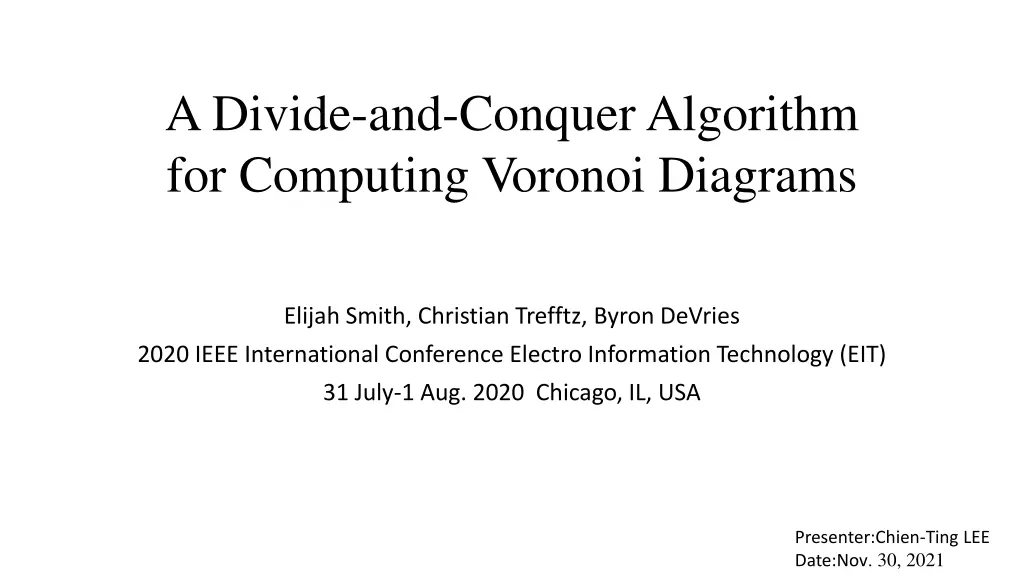
Compute Voronoi Diagrams Using Divide-and-Conquer Algorithm
Discover a divide-and-conquer algorithm for computing Voronoi diagrams efficiently by recursively subdividing the space based on proximity to seed points. This approach reduces computational complexity and streamlines the process of identifying the nearest location given a specific position.
Download Presentation

Please find below an Image/Link to download the presentation.
The content on the website is provided AS IS for your information and personal use only. It may not be sold, licensed, or shared on other websites without obtaining consent from the author. If you encounter any issues during the download, it is possible that the publisher has removed the file from their server.
You are allowed to download the files provided on this website for personal or commercial use, subject to the condition that they are used lawfully. All files are the property of their respective owners.
The content on the website is provided AS IS for your information and personal use only. It may not be sold, licensed, or shared on other websites without obtaining consent from the author.
E N D
Presentation Transcript
A Divide-and-Conquer Algorithm for Computing Voronoi Diagrams Elijah Smith, Christian Trefftz, Byron DeVries 2020 IEEE International Conference Electro Information Technology (EIT) 31 July-1 Aug. 2020 Chicago, IL, USA Presenter:Chien-Ting LEE Date:Nov. 30, 2021
Abstract Identifying the closest of a set of locations typically requires computing the distance to each of these locations, given a current position. However, Voronoi Diagrams precompute the geometric areas that each of these locations is closest to in order to ameliorate the cost of computing distances later on. Problematically, the initial computations required to generate a Voronoi Diagram can be computationally expensive. Naive approaches to generating discretized Voronoi Diagrams require every discretized position to be analyzed with the set of locations. This paper introduces a new algorithm to compute discretized Voronoi Diagrams using a divide-and-conquer approach. Rather than calculate every position, our approach calculates the positions at the four corners of a quadrant. If the corners belong to the same region, there is no need to subdivide this quadrant anymore; but if they are different than the original quadrant is subdivided into smaller quadrants. The process is repeated recursively until the entire diagram has been calculated appropriately.
Approach(1) Step 1: Calculate Points: Assuming that the plane on which the diagram will be computed is rectangular, find the seeds closest to each of the four corners of that rectangle using Euclidean distance. In other words, for every one of the corner points, calculate the distance to all seeds and select the closest seed to each of those corner points Step 2: Base Case: If all the corner points are closest to the same seed, then assign all points within the rectangle bounded by the four corner points to the region associated with the corners closest seed.
Approach(2) Step 3: Subdivide Case: If all the corner points are not closest to the same seed, subdivide the rectangle enclosed by the four corner points into four smaller rectangular fragments consisting of the top-left, top- right, bottom-left, and bottomright sub-rectangles of the original plane. Each of these 4 fragments of the original rectangle is then recursively processed by Step 1: Calculate Points
